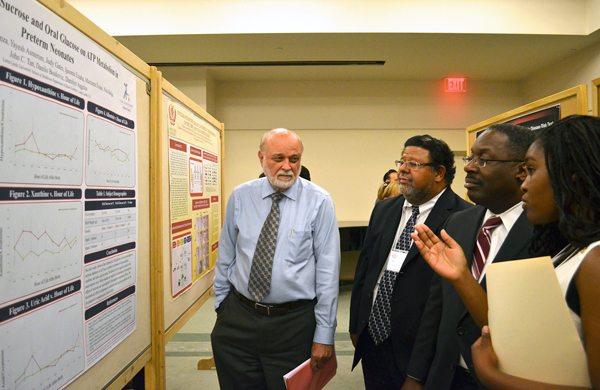About 80 students from diverse backgrounds from high schools and universities in the Inland Empire and nationwide capped off their summer by presenting posters on topics as diverse as human gene expression to treatment for spinal cord injury at a symposium on August 6 at Loma Linda University Health.
The students’ work was showcased at the 14th annual Health Disparities Research Symposium, presented by Loma Linda University School of Medicine Center for Health Disparities and Molecular Medicine. More than 300 researchers, students, community stakeholders, and university administrators attended the symposium.
The scientific posters represent the completion of the students’ work as participants in the center’s disparities research program, which pairs participating high school, undergraduate, post-graduate, and medical students with researchers and scientists at Loma Linda University Health to conduct scientific research.
The symposium featured as keynote speaker Johns Hopkins University professor Thomas A. LaVeist, PhD, a globally recognized expert in health disparities, who also spoke about the problems and prospects faced by researchers studying health inequalities.
“Passion can come at any age,” said Yamiko “Jessica” Chanza, 16, an incoming junior at Redlands High School, who wants to become a pediatric surgeon someday.
Chanza, whose family came from Malawi, Africa, said she had no idea what to expect when she joined the summer program, but knew that she wanted to make a difference in people’s health in some way.
“This experience really opened my eyes about the health disparities that exist in society, because even infants experience them,” said Chanza, who participated in a project looking at the effect of sugars on the metabolism of premature babies.
The Loma Linda University Health disparities research summer program, now in its 14th year, targets promising students from disadvantaged communities by Loma Linda University School of Medicine Center for Health Disparities and Molecular Medicine to encourage them to consider careers in medicine and biomedical research and increase diversity in the medical research field. The Loma Linda University School of Medicine Center for Health Disparities and Molecular Medicine has been designated by the National Institutes of Health (NIH) as a Center of Excellence on Health Disparities and Minority Health.
Research trainees are paired with academic mentors and engage in biomedical research conducted in various science, health and clinical departments at Loma Linda University Health and the Jerry L. Pettis VA Medical Center.
“What has been accomplished here today is that the students are becoming active participants in the dialogue concerning health disparities,” said Marino De Leon, PhD, director of Loma Linda University School of Medicine Center for Health Disparities and Molecular Medicine.
He said it’s important for young researchers to be aware of health disparities — often drawn along racial and socioeconomic lines — that exist among members of society, in order to come up with research and treatment models that are meaningful to people.
“Diseases impact people in their own context, and these students can become an agent of change for their own communities,” he said.

